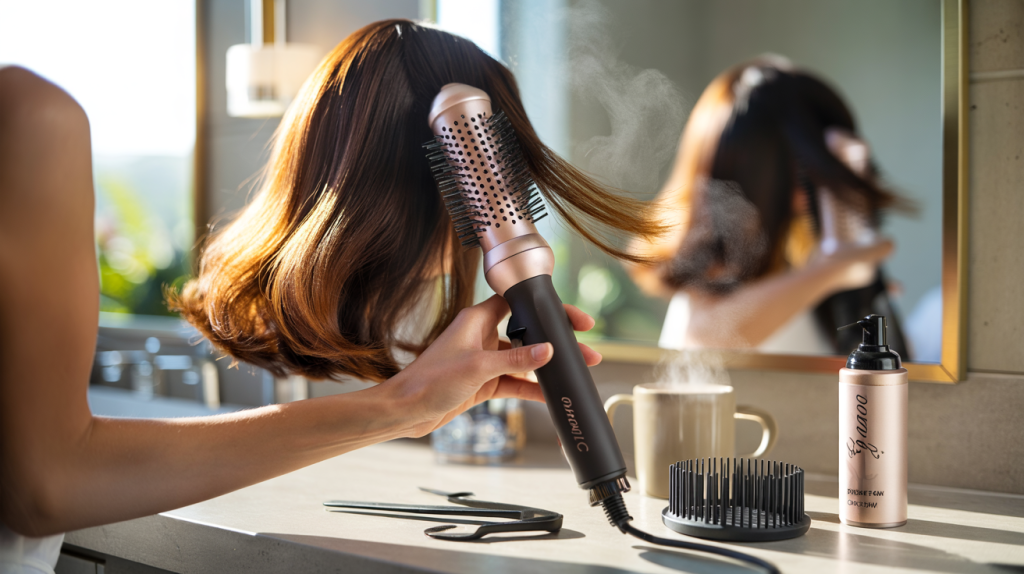Salon-smooth blowout in the time it takes coffee to brew. That is the promise of the brosse soufflante – the hot air brush designed to dry and shape hair at once, turning a rushed morning into a polished exit.
The context is simple and urgent : less time, more results. Unlike a classic dryer plus round brush, a hot air brush combines airflow and tension in one hand, cutting steps and friction. For thick, wavy, or fine hair, the goal stays the same : brushing rapide with fewer passes, less heat, and a finish that actually lasts.
Brosse soufflante for a quick blowout: what changes your routine
The main shift is mechanical. The tool grips hair like a round brush, while internal vents push warm air evenly along the strand. That means smoother cuticles, less juggling, and fewer hot spots. It saves minutes because drying and shaping happen together.
There is also control. Modern models regulate heat to avoid spikes that fry ends. Dyson reports its Airwrap measures airflow temperature 40 times per second and keeps it below 150°C to reduce extreme heat exposure (Dyson, product documentation, 2018 launch, updated 2024). Revlon’s One‑Step is a simpler, fixed‑barrel brush rated at 1100 W for steady airflow on a budget (Revlon, product specs, 2024).
Technique matters just as much. The American Academy of Dermatology Association advises keeping the dryer about 6 inches – roughly 15 cm – from hair and moving it continuously to limit damage, and suggests starting on the lowest heat that gets the job done (AAD, hair care guidance, accessed 2024). Those rules translate cleanly to hot air brushes and keep shine intact.
How to use a hot air brush for brushing rapide without damage
Rushing is tempting, but a small reset pays off. Towel-dry, detangle, and pre-dry roots to about 70 percent. Hair sets as it cools, so lock in shape: roll the ends under, pause, then release softly. Short sections create faster, cleaner passes than stuffing the barrel.
Common pitfalls show up quickly. Overloading the brush kills airflow and causes frizz. Parking the tool on one spot scorches cuticles. Skipping heat protectant raises breakage risk. AAD also recommends giving hair a short air-dry window before heat styling to reduce water swelling – a silent breakage driver when strands are overheated while still saturated (AAD, guidance, 2024).
Real life example. Shoulder-length, medium-density hair often lands a smooth blowout in 10 to 15 minutes with a 30 to 40 mm barrel, while long, thick hair benefits from oval barrels to boost root lift and cut drying bottlenecks. Shark’s FlexStyle system, introduced in 2022, leans on interchangeable barrels for faster section changes on busy mornings (Shark Beauty, launch materials, 2022).
Want a quick, repeatable routine that does not frizz by noon? The sequence below keeps it tight and consistent.
- Prep : heat protectant, then detangle from ends upward to avoid stretching wet hair.
- Pre-dry roots : 2 to 3 minutes on low or medium, lifting sections for airflow under the base.
- Work in small sections : 3 to 5 cm wide for even tension and faster smoothing.
- Roll and cool : hold for a few seconds, switch to cool shot, then unwind to set shape.
- Finish smart : a pea-size serum on ends only, so volume stays put at the crown.
Numbers and specs that matter: heat, watts, barrels
Heat control first. Tools that cap temperature near 150°C reduce cuticle cracking and color fade compared with hotter irons that can exceed 200°C. Dyson publishes that 150°C ceiling and real-time heat checks 40 times per second (Dyson, product documentation, 2024).
Power is next. A 1000 to 1200 W brush usually balances speed and noise for home use. Revlon’s One‑Step at 1100 W is a common reference point for single‑piece brushes (Revlon, specs, 2024). Higher watts do not always mean faster if vents are small or bristles choke airflow.
Barrel size changes the finish. A 30 mm barrel works for shaping bangs and tighter curves. A 40 mm barrel adds body on medium hair. Large oval barrels add lift at the root on long layers. Dyson’s 30 mm and 40 mm options arrived with the Airwrap in 2018, later expanded for multiple hair types (Dyson, product history, 2018–2024).
Bristle design also plays a role. Nylon pins grab and guide. Tufted boar or mixed bristles polish the surface. Ceramic coatings help spread heat evenly so strands accelarate drying without hot streaks.
Buying the right brosse soufflante for your hair type
Fine or fragile hair benefits from advanced heat control and smaller barrels for tension without overcooking. Look for multiple heat and speed settings, plus a cool shot. Ionic airflow can help reduce static on dry winter days.
Thick or curly hair thrives with stronger airflow and oval barrels that lift roots and stretch waves quickly. Detachable systems – like those introduced by Dyson in 2018 and Shark in 2022 – let users swap barrels as hair lengths or goals change, keeping speed high across seasons.
Color‑treated hair needs temperature discipline. Staying under that 150°C line from intelligent systems, and following AAD spacing and motion guidance, limits the fade and dryness many notice after repeated heat cycles. A lightweight protectant spray adds slip, so the brush glides instead of snags.
The last piece is fit. If mornings are tight, a single‑piece 1100 W oval brush is grab‑and‑go. If styling goals vary through the week, a multi‑styler with 30 and 40 mm barrels plus a smoothing brush builds volume one day and sleek ends the next. The result stays the same : brushing rapide that looks intentional, not improvised.
